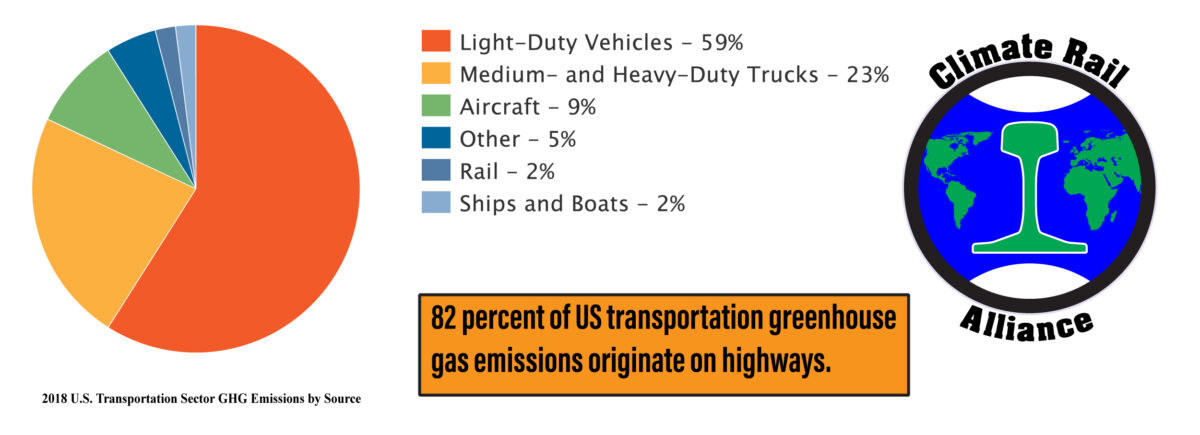The UN Intergovernmental Panel on Climate Change issued a report in 2018 stating that greenhouse gas emissions must be reduced by 45% of 2010 levels by 2030. Since then, greenhouse gas emissions have risen.
Rail transportation uses 2/3 less energy than highway transportation and produces 2/3 the greenhouse gas emissions.
Highway transportation is responsible for 82% of transportation greenhouse gas emissions. Air transportation is responsible for 9%. Rail transportation is responsible for 2%.
In Washington, highway transportation is responsible for 31 million tons of CO2 annually. Air transportation on the Vancouver BC – Seattle – Portland – Spokane routes, addressed by proposed Ultra High Speed Rail routes is responsible for 14 thousand tons.
The most effective climate emergency solution for the transportation sector is moving as much highway transportation to rail as possible in the shortest time.
Rail transportation safety is similar to air transportation safety. Both are substantially safer than highway transportation. Although the fatal derailment of 2017 is fresh in memory, the previous fatal derailment in Washington occurred in 1910. There have been three fatalities on I-5 within Lakewood since 2017.
Trucks do 99% of the damage to highways and pay about 30% of the cost.
Electric Vehicles can be part of a climate emergency solution but cannot fully address the problem. The equivalent electric power to the amount of highway fuel consumed in Washington would require the equivalent of two new Grand Coulee dams, 5 Columbia nuclear power stations, 7,000 wind turbines, or 181 square miles of solar generation.
Ultra High Speed Rail, while useful, is not a climate emergency solution. We have nine years to reduce emissions by over 45%. The environmental work, property acquisition, litigation, mitigation, and engineering prior to the start of construction can easily take twice that.
The Long Range Plan for Amtrak Cascades of Feb 2006 prepared as directed by RCW 47.79.20 is a comprehensive plan for higher speed rail service between Vancouver BC and Portland with a maximum speed of 110 mph providing 2 hour 30 minute schedule time between Seattle and Portland and 2 hour 45 minute travel time between Seattle and Vancouver BC. As directed in the legislation, this was to be the first, immediate step in developing high speed ground transportation. The program was to serve the dual purpose of providing reliable higher speed rail passenger service and to improve rail freight service, providing a means for innovative service to move truck transportation to rail. High Speed and Ultra High Speed Rail systems throughout the world depend upon the feeder service provided by service such as the Cascades service.
A similar service to the Cascades is important for transportation between the Puget Sound Region and central/eastern Washington. The Feasibility Study of an East-West Intercity Passenger Rail System for Washington State of 2020 provides an inadequate representation of east-west passenger service. The example schedules are almost guaranteed to minimize ridership. Successful service must be fast, frequent, and reliable. As with the Cascades service, the infrastructure to support such a service would be appropriate for improved freight service that could move freight from highway to rail.
The Long Range Plan for Amtrak Cascades provides a foundation for quickly implementing higher speed rail service that could have a substantial greenhouse gas reduction effect.
A similar plan for improved east-west passenger and improved freight rail service can be developed relatively quickly and implemented incrementally.
Considering these facts and the impending climate tipping point emergency, scarce funding would be better spent accelerating the full implementation of the Long Range Plan for Amtrak Cascades and a similar east-west rail program.
I understand that none of this can be accomplished without substantial federal funding. The new administration will soon be formulating plans for addressing the climate crisis in general and transportation infrastructure specifically. Washington State was able to receive one of the largest ARRA grants of 2008, largely because of the leadership of the Legislature in directing that a program be developed in advance of the availability of funds, and funding the development of the plan and some of the incremental implementation. Washington State would be well served for similar action now.
Thomas White
Climate Rail Alliance
taw@climaterailalliance.org
